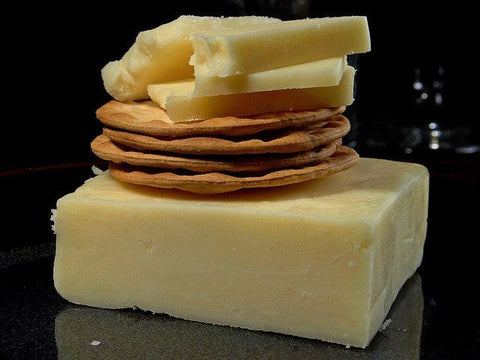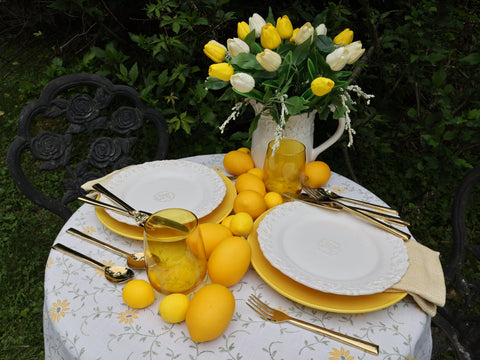What is Cheddar?
Cheddar is considered the most popular choice of cheese in the world (in the US, mozzarella is a close rival). Crafted from cow’s milk, the hard cheese has a rather sharp taste. According to legend, in the 12th Century, a milkmaid forgot a bucket of cow’s milk in a cave, and when she returned, the milk had hardened, and she decided to eat it. Cheddar village, situated in Somerset, England, is renowned as the birthplace of Cheddar cheese. Nestled on the southern edge of the Mendip Hills, it is close to the Cheddar Gorge, famous for its caves that were historically used for maturing the cheese.
Cheddar gained its popularity because of its long shelf life and portability, which made it perfect for soldiers and travelers. Soon, it became popular among England’s elite, and production expanded beyond local farmers to other parts of the world.
Today, Cheddar is produced in many parts of the world and is often made using goat and sheep’s milk.
How It's Made

Photo credit: @cowsandcocreamy on Instagram
The crafting of cheddar starts with the same basic method of adding cultures and rennet to curdle and acidify the cow’s milk. Once the curds are formed, they are then cut up and pressed together into slabs. The slabs are stacked and flipped repeatedly until most of the moisture is drained, leaving a dense, crumbly paste. This unique process is known as “cheddaring.”
Finally, the curd is milled into small chips before being salted, and the curd chips are placed into large cheese molds before being pressed. After pressing, the whole cheeses are often dressed in traditional cotton/muslin cloth and transferred to maturing stores.
Types of Cheddar:
Mild: Young and smooth with a subtle, buttery taste.
Medium: A slightly stronger flavor than mild.
Sharp: Cheddar gets a sharper taste as it ages. Cheddar can be aged anywhere from 1 year to over 10 years. The longer it ages, the sharper and tangier the cheddar flavor becomes.
Flavored: There are many other varieties of cheddar cheese, from savory garlic and smoked cheddar to an assortment of herb-enhanced blends.
Yellow, or orange?
Cheddar is naturally a light, creamy yellow. The bright orange cheddar you find in the market has had color added.
In the early days of cheesemaking, a cow’s milk would vary with the seasons. A summer milk might have a more golden hue because of the fresh forage available for the cows. Depending on their diets, cows can produce milk that has an orange (beta-carotene) color. Today, there are still slight differences in natural cheddar, going from white to yellow, depending on the season.
The orange-hued cheese became a favorite, so cheesemakers began “disguising” the seasonal variations with annatto. By adding annatto to the milk, there was less variation.

Photo by Aryan Dhuri: https://www.pexels.com
Annatto is a natural food coloring produced from the seeds of the tropical achiote tree. This natural food coloring is added to Cheddar to give it a rich orange hue. While annatto changes the look of the cheddar, it has no effect on the flavor.
How to serve it
Cheddar cheese is best served at room temperature, so take it out about 30 minutes before serving to bring out its full flavor.
A versatile cheese for your cheese platters, cheddar pairs well with many fruits, such as pears, cherries, dried apricots, and tart apples. Most crackers, plain or seeded, harmonize well with cheddar, and both sourdough and rye bread complement the sharpness of an aged cheddar. For wine, a red Pinot Noir or a white Riesling is a good choice.
When pairing cheddar with other foods, it’s best to avoid very sweet jams or jellies, as they can overpower the flavor of the cheddar. Similarly, seafood with a strong fishy taste can be too intense, as can ultra-spicy dishes, which tend to smother the cheddar rather than complement it.

The Twisted Urban Cheese Knife 3 PC Set includes a cheddar cheese knife. Also known as a mini cleaver or a cheddar cleaver, the knife has an extra-wide blade. The cleaver shape allows the cutter to use force and balance to press down and cut hard cheeses. Along with cheddar, this knife is ideal for other semi-hard to hard cheeses, like Gruyere, Colby, and Fontina.

Flat Cheese Knife
A flat cheese knife, or a chisel knife, is a great tool for cutting slices off aged cheddar cheese. The blade is held vertically over the cheese, and the handle is used to push downwards. A wide paddle-like blade, the flatware cheese knife is ideal for other semi-hard cheeses like Asiago, Provolone, and Swiss cheese. Ideal Cheeses: Provolone, Swiss, Gruyere, Asiago
Here is a video demonstrating how to use a flat cheese knife to cut cheddar cheese:
Can you bake it?

Cheddar cheese is a popular choice for foods or dishes that can be enhanced with a thin coating of delicious, melted cheese. Cheddar cheese is perfect for sandwiches, burgers, and quesadillas.
And who can resist the buttery, crispy, and cheesy flavor of a grilled cheese sandwich? Cheddar cheese is the classic choice for this popular sandwich.
Cheddar gets a soft, stringy consistency when heated and is often used to top baked dishes. Grating the cheese makes it quick and easy to melt in dishes like macaroni and cheese and over nachos.
Grated cheddar cheese can be sprinkled over casseroles, baked potatoes, or even salads. Cheddar is a versatile cheese that adds a satisfying flavor to a wide range of dishes.
How to store it
Remove the cheddar from its original packaging and wrap it tightly in parchment paper, wax paper, or cheese paper.
Cheese paper is a waxy paper that is often used to wrap artisan cheese. It is coated in wax with a porous layer of plastic on the inside that allows to cheese to breathe. Don’t worry if you don’t have cheese paper, though. Use parchment paper and tape it closed, so the cheese can breathe without being exposed to strong odors from other foods.
🧀🧀🧀
With its range of flavors and textures, Cheddar cheese is a great choice for your cheese boards. With the right cheese knife set, cheddar is easy to cut into a variety of shapes and sizes.
Head photo: https://pixabay.com



